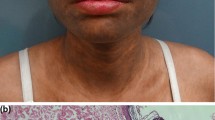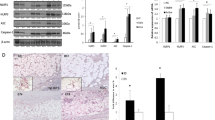Abstract
Alopecia areata incognita (AAI) is a type of diffuse hair fall with no confirmatory diagnostic test. The UL16 binding protein-3 (ULBP3) is ligands for natural-killer group 2, member D (NKG2D) receptor. It is a key regulator of both innate and adaptive immune responses. In the normal hair follicle, ULBP3 is turned off. However, different studies reported its high level in alopecia areata (AA). Therefore, this study was done to evaluate ULBP3 in AAI in comparison with telogen effluvium (TE), female pattern hair loss (FPHL), and normal hair. Biopsy specimens from 36 females suffering from AAI, 15 with FPHL, nine with TE, and ten healthy female controls were subjected to the immunogenetic detection of ULBP3 levels by real-time polymerase chain reaction (PCR). A high statistically significant increase in ULBP3 level in AAI patient group compared with FPHL, TE, and normal hair was detected. ULBP3 levels were positively correlated with the age and duration of the disease. Accordingly, ULBP3 may act as a confirmatory test for AAI. ULBP3 may be implicated in the disease pathogenesis, progression, and chronicity, and AAI may be a subtype of AA.





Similar content being viewed by others
References
Eagle RA, Traherne AJ, Hair JR, Jafferji I, Trowsdale (2009) ULBP6/RAET1L is an additional human NKG2D ligand. Eur J Immunol 39:3207–3216
Ito T, Ito N, Saatof M et al (2008) Maintenance of hair follicle immune privilege is linked to prevention of NK cell attack. J Invest Dermatol 128:1196–1206
Lacarrubba F, Dall’ Oglio F, Rita Nasca M, Micali G (2004) Videodermatoscopy enhances diagnostic capability in some forms of hair loss. Am J Clin Dermatol 5:205–208
Livak KJ, Schmittgen TD (2001) Analysis of relative gene expression data using real-time quantitative PCR and the 22DDCT. Methods 25:402–408
Martinez Mir A, Zlotogorski A, Gordon D et al (2007) Genome wide scan for linkage reveals evidence of several susceptibility loci for alopecia areata. Am J Hum Genet 80:316–328
Miteva M, Misciali C, Fanti PA, Tosti A (2012) Histopathologic features of alopecia areata incognito: a review of 46 cases. J cutan pathol 39:596–602
Molina L, Donati A, Valente NSY, Romiti R (2011) Alopecia areata incognita. Clinics 66:513–515
Petukhova L, Duvic M, Hordinsky M et al (2010) Genome-wide association study in alopecia areata implicates both innate and adaptive immunity. Nature 466:113–117
Rakowska A, Slowinska M, Kowalska-Oledzka E, Olszewska M, Rudnicka L (2009) Dermoscopy in female androgenic alopecia: method standardization and diagnostic criteria. Int J Trichol 1:123–130
Serrano-Falcón C, Fernández-Pugnaire MA, Serrano-Ortega S (2013) Hair and scalp evaluation: the trichogram (english edition). Actas Dermosifiliogr 104:867–876
Shrivastava SB (2009) Diffuse hair loss in an adult female: approach to diagnosis and management. Indian J Dermatol Venereol Leprol 75:20–27 (quiz 27–28)
Torres F, Tosti A (2015) Female pattern alopecia and telogen effluvium: figuring out diffuse alopecia. Semin Cutan Med Surg 34:67–71
Tosti A, Whiting D, Iorizzo M, Pazzaglia M, Misciali C, Vincenzi C (2008) The role of scalp dermoscopy in the diagnosis of alopecia areata incognita. J Am Acad Dermatol 59:64–67
Van Neste D (2006) Female patients complaining about hair loss: documentation of defective scalp hair dynamics with contrast-enhanced phototrichogram. Skin Res Technol 12:83–88
Author information
Authors and Affiliations
Corresponding author
Ethics declarations
Funding
No funding sources supported this work.
Conflict of interest
No conflict of interest.
Rights and permissions
About this article
Cite this article
Moftah, N.H., El-Barbary, R.A.H., Rashed, L. et al. ULBP3: a marker for alopecia areata incognita. Arch Dermatol Res 308, 415–421 (2016). https://doi.org/10.1007/s00403-016-1652-9
Received:
Revised:
Accepted:
Published:
Issue Date:
DOI: https://doi.org/10.1007/s00403-016-1652-9




